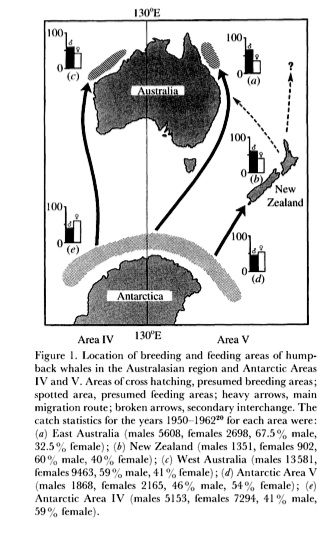Advait Jukar & Laura Bradley
Reed College
Adaptative Value
Behavioral adaptive value: the function a particular behavior serves to increase the reproductive fitness of an organism.
Humpback whales migrate [see Figures 1, 2, 3 and 4]from their summer feeding grounds to their winter breeding grounds to mate and give birth. The warmer, calmer water allows the calves to grow in environment that does not require the protective adult blubber layer. The seasonal reproductive cycle and the 12 to 14 month gestation period gives rise to winter births.
Skewed sex ratio in migration and its significance
 Not all humpbacks migrate to the breeding grounds at the same time. The observations at the breeding grounds by whalers and recent studies of the Australian populations have shown a male-biased sex ratio of 2.4 to 1 (Figure 8) (Brown et al 2006). Mature females that are in their late lactating period reach the wintering grounds first to undergo parturition, whereas females that have become pregnant during migration return to the feeding grounds early in order to maximize reproductive success by increasing their energy stores (Craig & Herman 1997). Females that have just given birth stay the longest in the winter grounds to raise their calves. Many juveniles are too immature to reproduce and unable to accumulate the energy reserves to migrate and survive the winter breeding grounds that are scare in food. These youngsters arrive to and depart from the breeding grounds earlier than other whales, and have been reported to arrive with their mothers (Craig & Herman 1997). Females with calves tend to reach the breeding grounds later than females without calves. As such, males time their migratory routes to overlap with both groups, mating with calf-less females upon arrival and females with caves upon departure. Though the males will inseminate both classes, they exhibit a preference for calf-less females that ovulate more frequently (Craig & Herman 1997).
Not all humpbacks migrate to the breeding grounds at the same time. The observations at the breeding grounds by whalers and recent studies of the Australian populations have shown a male-biased sex ratio of 2.4 to 1 (Figure 8) (Brown et al 2006). Mature females that are in their late lactating period reach the wintering grounds first to undergo parturition, whereas females that have become pregnant during migration return to the feeding grounds early in order to maximize reproductive success by increasing their energy stores (Craig & Herman 1997). Females that have just given birth stay the longest in the winter grounds to raise their calves. Many juveniles are too immature to reproduce and unable to accumulate the energy reserves to migrate and survive the winter breeding grounds that are scare in food. These youngsters arrive to and depart from the breeding grounds earlier than other whales, and have been reported to arrive with their mothers (Craig & Herman 1997). Females with calves tend to reach the breeding grounds later than females without calves. As such, males time their migratory routes to overlap with both groups, mating with calf-less females upon arrival and females with caves upon departure. Though the males will inseminate both classes, they exhibit a preference for calf-less females that ovulate more frequently (Craig & Herman 1997).
Humpback whales cover greater distances during migration than other balenopterids and must consume a great amount of energy. During the feeding season humpbacks increase their body mass two fold (Brown et al 2006). Pregnant and lactating females encounter even higher energy costs by providing nutrients for their offspring. Body condition and size have been hypothesized to be more important for the reproductive success of humpback females than males (Craig & Herman 1997). Females lactate for longer periods in the winter breeding grounds than the summer feeding grounds, incurring a substantial loss of energy. An effective way of conserving this energy and maximizing reproductive success could be to decrease time spent migrating, in turn increasing time spent on the feeding grounds. It has also been seen that females that are large and sexually mature enough to reproduce successfully will spend more time in the breeding grounds relative to the smaller and less sexually mature females. Females that are recently pregnant have been reported to leave the breeding grounds earlier than males and non-pregnant females. These females may leave early in order to forage and build their size and energy stores that are essential to reproductive success. It has also been observed that some females that get pregnant on the migration return to the feeding grounds without completing the migration (Craig & Herman 1997).